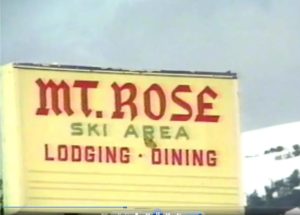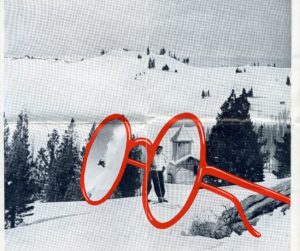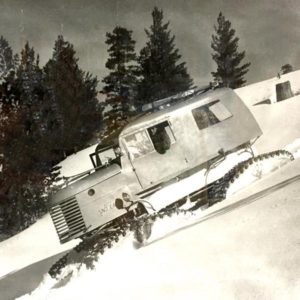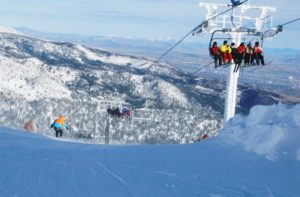BY JEFFREY WEIDEL
Although now just an amusing footnote in the annals of Mt. Rose ski resort history, old-timers can recall a time when this mountainous area in the Carson range was quite the winter battleground.
Starting in the mid-1960s and continuing for more than two decades, one side of Slide Mountain was Slide Mountain ski resort, while the other side contained Mt. Rose Ski Area.

Competing for the same ski crowd, this was not a harmonious relationship. Although some of the trails intersected, it wasn’t a good idea to get stuck on the wrong side of either resort with the wrong lift ticket. It often led to a long hike back to friendly territory.
“It was a Hatfield and McCoy area back then. There is some good old folklore about how the two resorts didn’t get along,” recalls Mike Pierce, the Mt. Rose marketing director for the past 21 years. “It was kind of an Iron Curtain at the time. Unless you got a friendly lift operator, you weren’t allowed to travel between the two resorts.”
The bickering feud eventually subsided. The “Iron Curtain” was lifted in 1987 when Slide Mountain ski resort went bankrupt and was absorbed by Mt. Rose. It’s a tale that is being retold this year as Mt. Rose celebrates its 50th anniversary.
Among the 15 Lake Tahoe-area ski resorts, Mt. Rose can probably trace its roots back further than any of the neighboring resorts with the exception of Sugar Bowl.
Mt. Rose’s modest beginning took root when Wayne Paulson built and operated the Mt. Rose Upski and a ski school in 1939. Devoted skiers would hike up the 9,700-foot peak of Slide Mountain and head back down on their crude wooden skis.

Constructed on the east slope of Slide Mountain, which is currently the East Bowl of Mt. Rose, the Reno Ski Bowl opened in 1953 and was at one point connected to the legendary Sky Tavern by the old “Ringer Chair.” One rusty lift tower is the only thing that remains from the Ringer.
In the mid-1960s, Switzerland-born Fritz Buser was one of the early investors in the resort when principal owner Jim Leuscher changed the name to Mt. Rose Ski Area. Leuscher frequently borrowed money from Buser to keep financing the struggling resort, and paid him back in stock options.
Buser, who owned Henke ski boot company, eventually became the majority owner of Mt. Rose in 1971. An avid skier, Buser is given credit for many of the current lift system upgrades and resort amenities. Buser, now 94, lives in Switzerland and his son, Kurt, remains active in Mt. Rose’s overall operations.
MT. ROSE SKI RESORT
Established: 1964 when it was called Mt. Rose Ski Area
Lifts/trails: 8 lifts, 60-plus trails
Base/Summit: 8,260 feet/9,700 feet
Skiable area: 1,200 acres
Location: 22222 Mt. Rose Highway, Reno, Nevada
Website: www.skirose.com
A midsize resort with eight lifts and 60-plus trails, Mt. Rose remains a favorite of the Reno crowd. Pierce estimates that 50 to 60 percent of the passholders are from Reno area. It’s a 30-minute drive from downtown Reno to the Mt. Rose parking lot.
Mt. Rose also has its share of passholders who live in Lake Tahoe. One of them is Gary Fung, a commercial real estate executive from Incline Village, who loves Mt. Rose’s convenience.

“It is very important to me that skiing be easy and accessible,” said Fung, who says he skis around 92 days per year, sometimes with his two sons. “I can’t tolerate the trudge back and forth to the major west lake resorts (Squaw, Alpine). Although I have an Epic Pass, even Northstar is inconvenient for me, at 13 miles away and a tough walk through the Northstar Village. With Mt. Rose I can be at the top and starting to ski in 22 minutes from the moment I start my car at home.”
Fung also likes Mt. Rose ski resort due to its location and high elevation. The resort has the highest base area (8260 feet) and its summit (9700 feet) is third behind Heavenly and Kirkwood among its Tahoe contemporaries. The high elevation means there are rarely winter rains and the resort’s northern exposure captures snow when other resorts receive very little or none.
That was evident in early February when Mt. Rose got two feet of snow in one day, the most in the region.
“The best thing about Mt. Rose is the elevation. Often when other resorts get rain, Mt. Rose gets snow,” Fung said. “I have always felt that Mt. Rose has superior conditions early and late in the season.”
Mt. Rose ski resort made two major additions in the past decade, adding a quad chair and opening the Chutes expert terrain in 2004 and unveiling the upscale Winter Creek Lodge in 2009. The 200-plus acre Chutes area, which opened for the first time this season in early February, features steep pitches between 40-55 degrees.

This season snow has once gain been an issue for all skiers and riders, yet it hasn’t stopped the Eric Huang and his two children from making frequent treks to Mt. Rose from their San Jose home. They enjoy the resort and also the great bargain ski-and-stay lodging deals in Reno.
Although it lacks the sophistication of some major ski resorts in Lake Tahoe, Mt. Rose ski resort has carved out its own niche.
“The snow is always well groomed, whether manufactured or real. I don’t know how they do it,” Huang said. “I find most ski places in the Reno-Tahoe area to be more pretentious and clearly catering to the experienced skier and the ones with tons of money to spend. I feel like Mt. Rose is the most friendly. Mt. Rose works hard to give my family a great experience every time we visit. Everyone at Mount Rose hustles.”
Jeffrey Weidel can be reached at [email protected]. Thanks for visiting his winter website at www.tahoeskiworld.com